Indonesia Textile Manufacturing Market Size
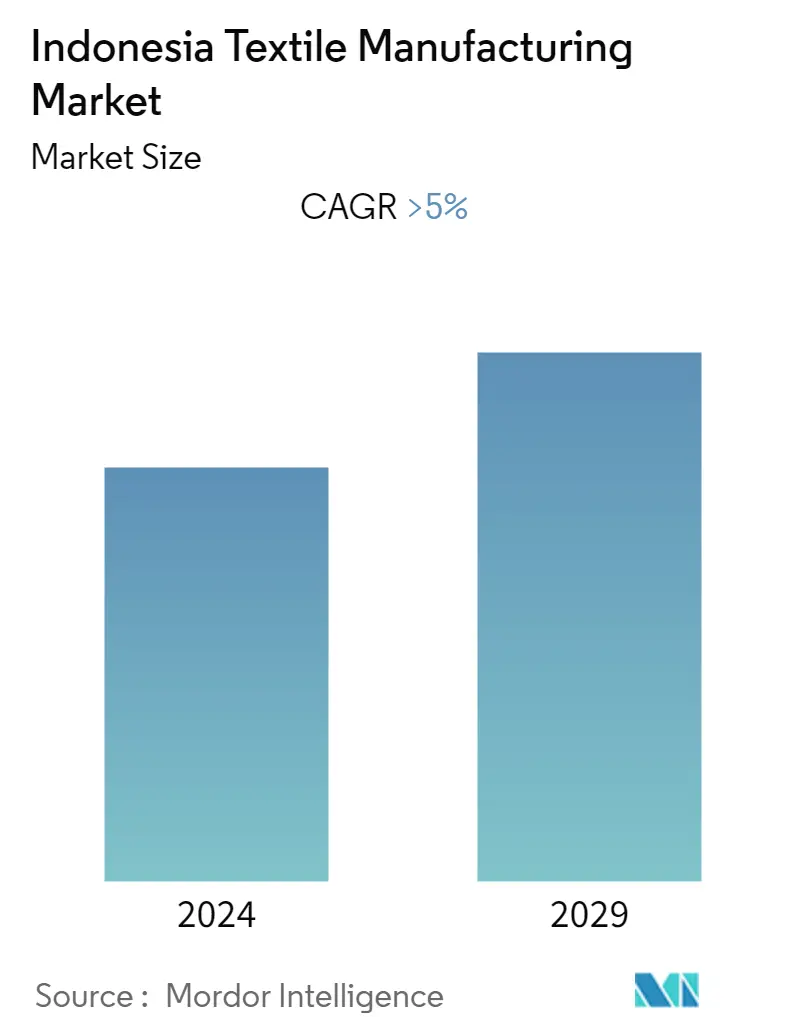
| Study Period | 2020 - 2029 |
| Base Year For Estimation | 2023 |
| Forecast Data Period | 2024 - 2029 |
| Historical Data Period | 2020 - 2022 |
| CAGR | 5.00 % |
| Market Concentration | Low |
Major Players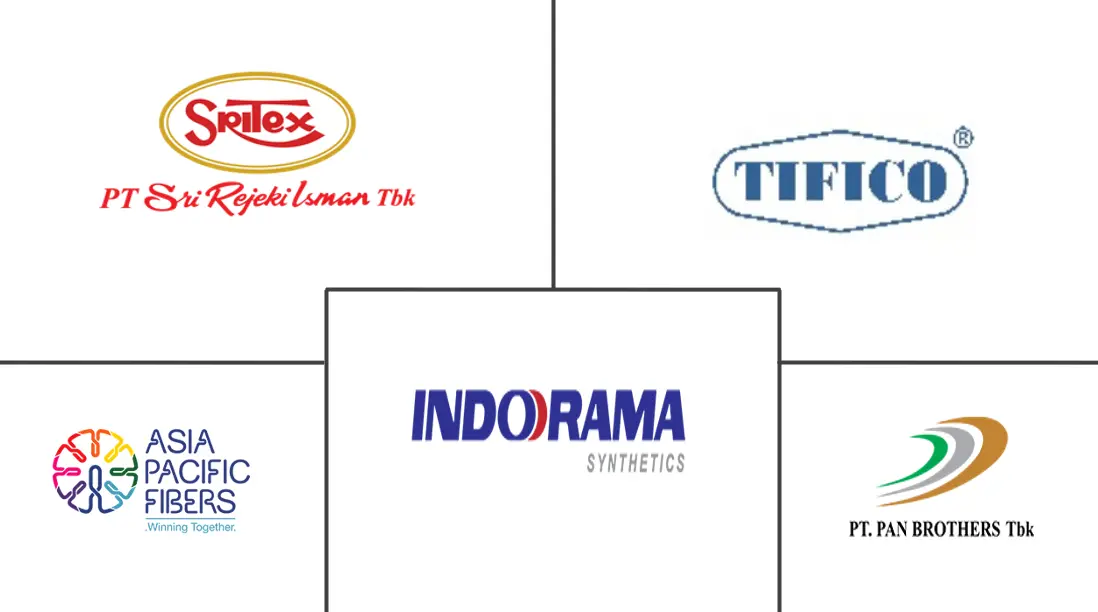
*Disclaimer: Major Players sorted in no particular order |
Indonesia Textile Manufacturing Market Analysis
The Indonesia Textile Manufacturing Market is expected to record a CAGR of greater than 5% during the forecast period (2023-2028).
- Indonesia's push to new export markets, leveraging its ties with Muslim nations, is also contributing to development. Several Muslim-majority nations now account for half of Indonesia's trade missions and discussions, and textiles are now heavily exported there. As clothing manufacturers continue to relocate manufacturing away from China, Indonesia offers an appealing option. China's worldwide cotton imports are declining, and most cotton exports are being channeled to competitive nations such as Indonesia. China's cotton imports are expected to climb by just 3.5 million bales between 2021 and 2030, compared to an anticipated 8.1 million bales for the major rival garment nations, Indonesia, Vietnam, Pakistan, Bangladesh, and Turkey combined.
- An increase in exportation to major countries like the United States, the European Nations, and the Middle East has led to the rapid development of the Textile Manufacturing Industry. High dependency on imported raw materials is likely to act as a restraint for the market. To expand the Indonesian Textile Manufacturing Industry, the Indonesian government has encouraged Textile Product Industry ( TPT ) to explore the fashion industry and meet its demand, which will open many new opportunities for this industry during the forecast period.
- Companies in the industry can profit from high-quality products, substantial government backing, and cheap labor costs. Nonetheless, outdated gear and a reliance on imported raw materials result in lower manufacturing costs. Companies looking to enter the textile and apparel manufacturing sector in Indonesia will discover significant development potential in an already robust market.
Indonesia Textile Manufacturing Market Trends
This section covers the major market trends shaping the Indonesia Textile Manufacturing Market according to our research experts:
Increase in Exports driven by the Trade Agreements Boosting the Market
Textiles and textile products produced foreign money with an export value of USD 13.02 billion, according to Ministry of Industry data. As of July 2022, the industry had an export value of USD 6.08 billion, accounting for 5.51% of total exports. Textile exports are expected to surpass USD 14 billion by the end of 2022, according to the ministry. These figures put Indonesia among the top 10 textile and textile product exporters in the world, with China (the world's biggest textile producer, accounting for over half of global textile output), India, the United States, Brazil, and Thailand.
Indonesia's textile industry is one of the top ten contributors to the nation's manufacturing sector, accounting for 6.7 % of total production. Indonesia is 12th among the leading textiles and apparel exporters in the Association of Southeast Asian Nations (ASEAN) region. Indonesian textile products are shipped in huge amounts to the Middle East and Africa, which has created a notable positive impact on the textile manufacturing market in Indonesia. The country is trying to expand its trade with the Muslim world to tap new export markets and boost trade. The Muslim world has started giving preference to Indonesia for textiles against China.
The country's stable economy, efforts in expansion, and efforts to meet new-fashion demands are some of the factors that have attracted more investment in this industry. Australia and Indonesia have signed the Indonesia-Australia Comprehensive Economic Partnership Agreement. It is reported that the textile industry of Indonesia is expected to benefit the most from the agreement. An increase in exportation to major countries like the United States, the European Nations, and the Middle East has led to the rapid development of the textile manufacturing industry.
The country now is poised to outpace Thailand and Malaysia as a major regional manufacturing and export hub, and investors are increasingly choosing Indonesia over China, Thailand, and Malaysia, drawn in by the country's relative stability, sizeable low-cost labor pool, and large domestic market.
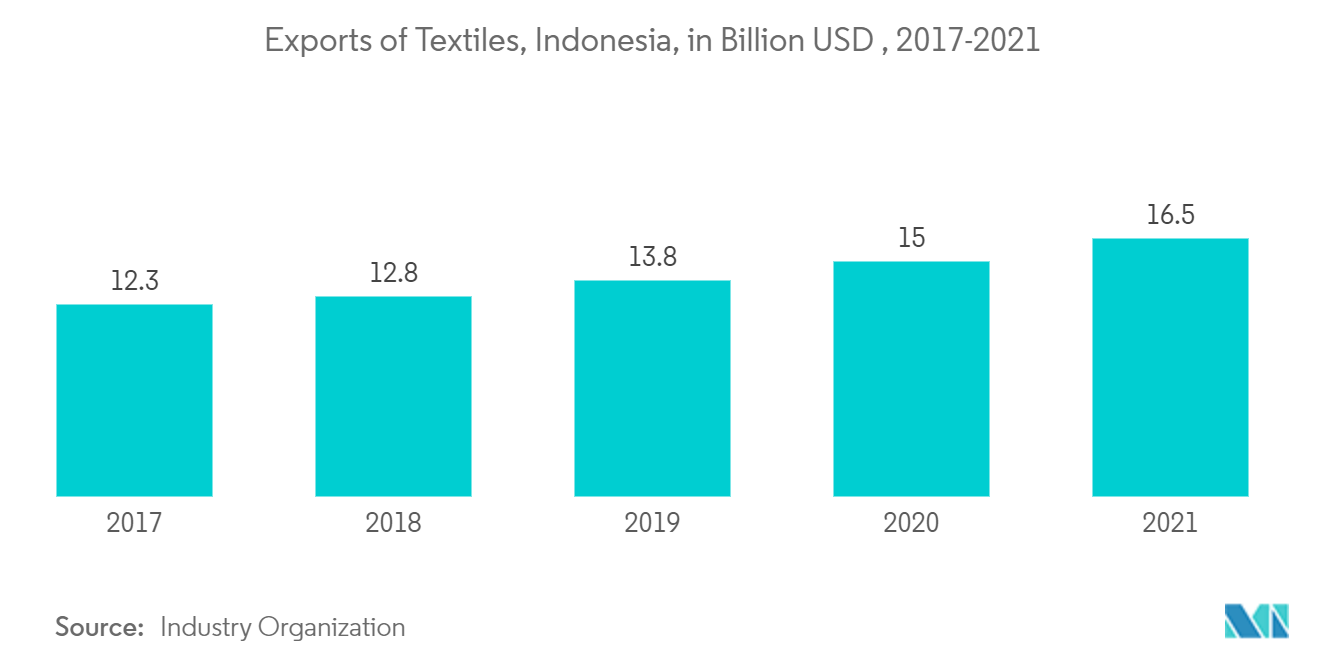
Growing Urbanization is Driving the Market
In 2021, metropolitan regions and cities housed 57.29 percent of Indonesia's total population. While urbanization in Indonesia has been slower than in many other nations throughout the world, it is presently moving at a rapid pace. Indonesia's home textile market is anticipated to grow at an increased rate due to the growing fashion sensitivity of urban consumers. Rapid urbanization and industrialization have resulted in improvements in the standard of living along with an increase in the disposable income of the population.
These are some factors projected to support the revenue growth of the Indonesian textile manufacturing industry. The country's population is expected to climb much higher. Indonesian Ministry reports also state that the birth rate in Indonesia is much higher than the death rate (except during the COVID-19 period). This is the major reason for population growth in Indonesia.
With the increase in population and the accompanying changes in consumer trends, the demand for different varieties of textiles is expected to surge. With the increasing availability of wide varieties of clothing in every sector and for every purpose with different fabrics available, the market is gaining strong attraction among consumers. Consumers want to explore the market for different varieties and cost-availability options.
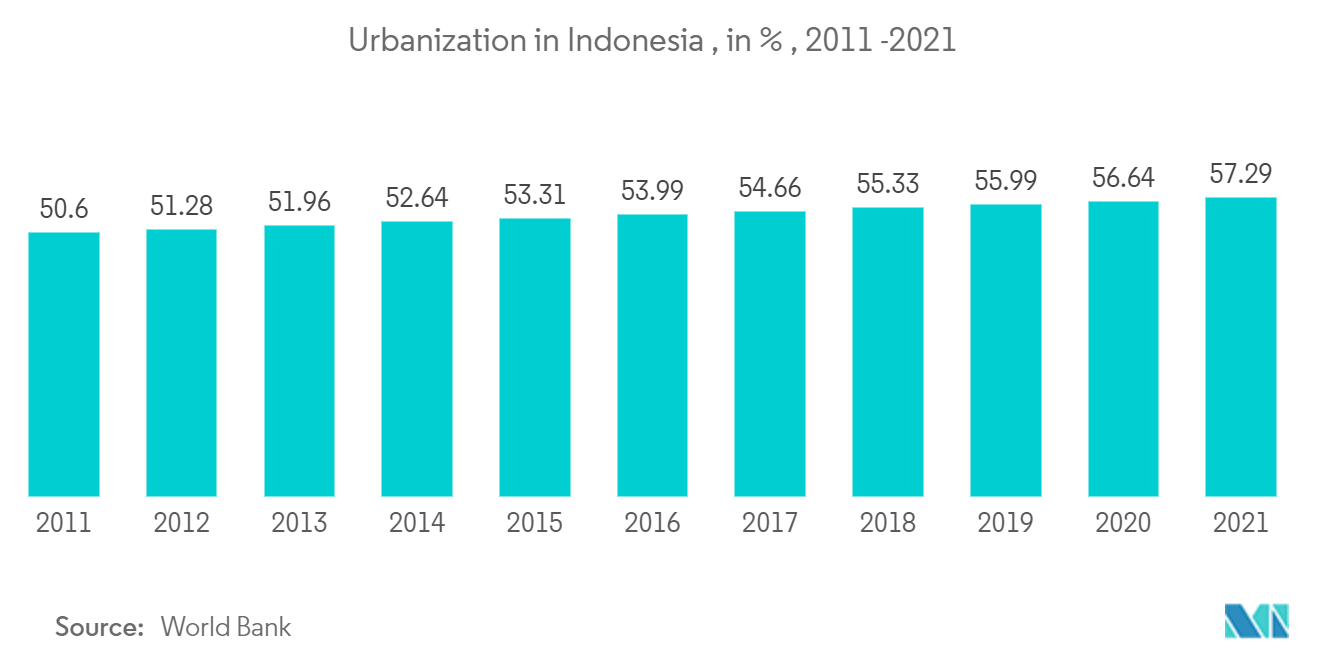
Indonesia Textile Manufacturing Industry Overview
The Indonesian textile manufacturing industry is highly fragmented in nature, with the dominance of a large number of local and international players in the market. The key players in the market occupy less than 40 % of the total market share.
The key players in the Indonesian Textile Manufacturing Industry market are PT. Asia Pacific Fibers Tbk, Indorama Corporation (PT. Indo-Rama Synthetics TBK), PT. Sri Rejeki Isman TBK, PT. Tifico Fiber Indonesia TBK, PT. Pan Brothers TBK and other companies.
Indonesia Textile Manufacturing Market Leaders
-
PT Asia Pacific Fibers TBK
-
Indo - Rama synthetics TBK
-
PT Sri Rejeki Isman TBK
-
PT Tifico Fiber Indonesia TBK
-
PT Pan Brothers TBK
*Disclaimer: Major Players sorted in no particular order
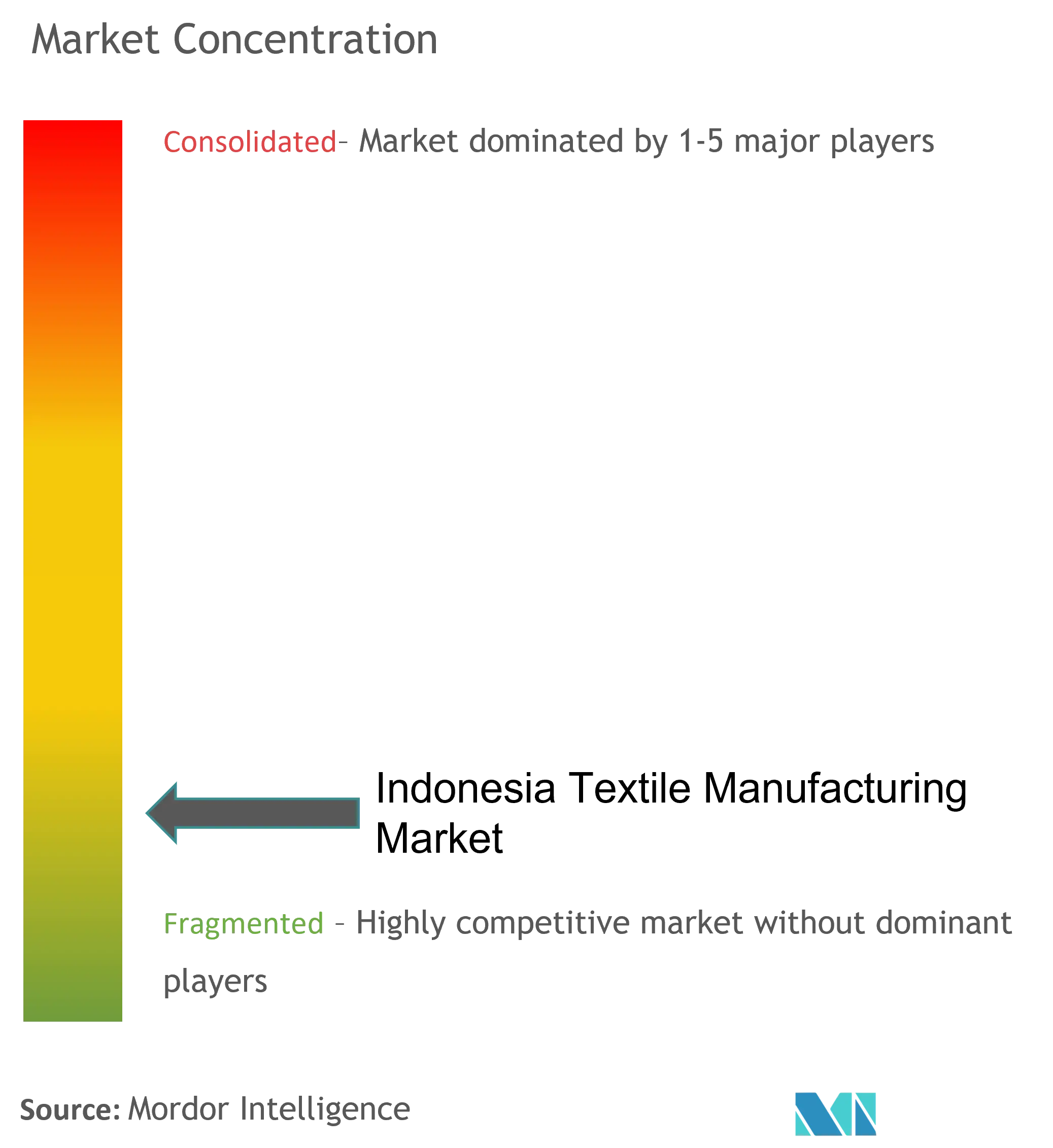
Indonesia Textile Manufacturing Market News
January, 2022: Toray Industries of Indonesia declared its collaboration with Soramitsu Company of Japan, which is a blockchain-based company. The main aim behind this collaboration is that Toray Industries want to focus on integrating proprietary recycling of fabrics, biomass, and other sustainable technologies that can contribute to a closed-loop economy means reusing fabrics. It also looks to integrate its product supply chain with Soramitsu's blockchain technologies to enhance traceability in product collection, reuse, and other processes. Such an approach would help engage all supply chain stakeholders in achieving a closed-loop economy.
March, 2021: PT Pan Brothers PTK announced its collaboration with the US Trust Cotton protocol. The main aim of this collaboration is that PT.Pan Brothers PTK wants to ensure their customers that they have approved supply chain partners for brands and retailers who are sourcing more sustainably grown cotton. A combination of a unique credit accounting system and the Permanent Bale Identification (PBI) system enables brands to have transparency throughout the supply chain to finished products.
Indonesia Textile Manufacturing Market Report - Table of Contents
1. INTRODUCTION
- 1.1 Study Deliverables
- 1.2 Study Assumptions
- 1.3 Scope of the Study
2. RESEARCH METHODOLOGY
3. EXECUTIVE SUMMARY
4. MARKET INSIGHTS AND DYNAMICS
- 4.1 Market Overview
- 4.2 Market Drivers
- 4.3 Market Restraints/Challenges
- 4.4 Market Opportunities
- 4.5 Value Chain/Supply Chain Analysis
-
4.6 Porter's Five Forces Analysis
- 4.6.1 Threat of New Entrants
- 4.6.2 Bargaining Power of Buyers/Consumers
- 4.6.3 Bargaining Power of Suppliers
- 4.6.4 Threat of Substitute Products
- 4.6.5 Intensity of Competitive Rivalry
- 4.7 Technological Innovations in the industry
- 4.8 Impact of COVID - 19 on the Industry
- 4.9 Government Initiatives to Attract Investment in the Industry
5. MARKET SEGMENTATION
-
5.1 By Process Type
- 5.1.1 Spinning
- 5.1.2 Weaving
- 5.1.3 Knitting
- 5.1.4 Finishing
- 5.1.5 Other Process Types
-
5.2 By Textile Type
- 5.2.1 Fiber
- 5.2.2 Yarn
- 5.2.3 Fabric
- 5.2.4 Garments
- 5.2.5 Other Textile Types
-
5.3 By Equipment and Machinery
- 5.3.1 Simple Machines
- 5.3.2 Automated Machines
- 5.3.3 Console/Assembly Line Installations
6. COMPETITIVE LANDSCAPE
- 6.1 Market Competition Overview
-
6.2 Company Profiles
- 6.2.1 PT Asia Pacific Fibres TBK
- 6.2.2 Indo - Rama Synthetics TBK
- 6.2.3 PT Sri Rejeki Isman TBK
- 6.2.4 PT Tifico Fiber Indonesia TBK
- 6.2.5 PT Pan Brothers TBK
- 6.2.6 PT Ever Shine Tex TBK
- 6.2.7 PT Trisula Textile Industries TBK
- 6.2.8 PT Century Textile Industry TBK (Toray Industries)
- 6.2.9 PT Polychem Indonesia TBK
- 6.2.10 PT Argo Pantes TBK*
- *List Not Exhaustive
7. MARKET OPPORTUNITIES AND FUTURE TRENDS
8. APPENDIX
** Subject To AvailablityIndonesia Textile Manufacturing Industry Segmentation
Textile refers to materials that are made from fibers, thin threads, or filaments that are natural or manufactured, or a combination. Textiles are created by interlocking these yarns in specific patterns resulting in a length of cloth. The textile fibers are spun into yarn and then made into fabric by different methods like weaving, knitting, and felting.
The Indonesian textile manufacturing market is segmented by textile type (fiber, yarn, fabric, garment, and other textiles ), process type (spinning, weaving, knitting, finishing, and other process types), and machinery type (simple machines, automated machines, and console/ assembly line installations).
The report offers market size and forecast for Indonesia Textile Manufacturing Market value (USD Billion) for all the above segments. The report also covers the impact of COVID-19 on the market.
| By Process Type | Spinning |
| Weaving | |
| Knitting | |
| Finishing | |
| Other Process Types | |
| By Textile Type | Fiber |
| Yarn | |
| Fabric | |
| Garments | |
| Other Textile Types | |
| By Equipment and Machinery | Simple Machines |
| Automated Machines | |
| Console/Assembly Line Installations |
Indonesia Textile Manufacturing Market Research FAQs
What is the current Indonesia Textile Manufacturing Market size?
The Indonesia Textile Manufacturing Market is projected to register a CAGR of greater than 5% during the forecast period (2024-2029)
Who are the key players in Indonesia Textile Manufacturing Market?
PT Asia Pacific Fibers TBK, Indo - Rama synthetics TBK, PT Sri Rejeki Isman TBK, PT Tifico Fiber Indonesia TBK and PT Pan Brothers TBK are the major companies operating in the Indonesia Textile Manufacturing Market.
What years does this Indonesia Textile Manufacturing Market cover?
The report covers the Indonesia Textile Manufacturing Market historical market size for years: 2020, 2021, 2022 and 2023. The report also forecasts the Indonesia Textile Manufacturing Market size for years: 2024, 2025, 2026, 2027, 2028 and 2029.
Indonesia Textile Manufacturing Industry Report
Statistics for the 2023 Indonesia Textile Manufacturing market share, size and revenue growth rate, created by Mordor Intelligence™ Industry Reports. Indonesia Textile Manufacturing analysis includes a market forecast outlook to 2029 and historical overview. Get a sample of this industry analysis as a free report PDF download.



